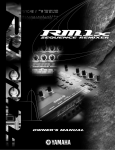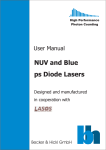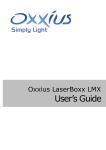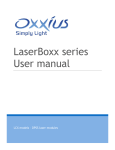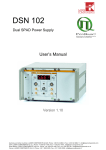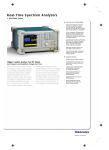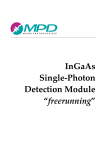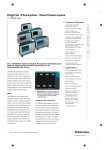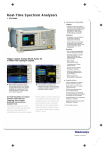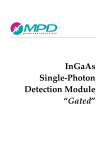Download Abberior Instruments Pulsed Diode Laser PDL 561 / PDL 594
Transcript
Abberior Instruments Pulsed Diode Laser PDL 561 / PDL 594 Operating Manual Last change: 2015-04-08 Subject to change without notice. Page 1/14 Contents 1 Introduction _________________________________________________________________________ 3 2 Laser Safety _________________________________________________________________________ 3 2.1 Safety Features __________________________________________________________________ 3 2.1.1 Interlock ____________________________________________________________________ 3 2.1.2 Manual Shutter (Optional) _____________________________________________________ 3 2.1.3 Key Switch __________________________________________________________________ 4 2.1.4 Status LEDs _________________________________________________________________ 4 2.1.5 Warning Labels ______________________________________________________________ 4 2.2 Safety Precautions ________________________________________________________________ 4 3 Operating Instructions _________________________________________________________________ 5 3.1 Laser Installation _________________________________________________________________ 5 3.1.1 Package Contents ____________________________________________________________ 5 3.1.2 Mounting the Laser Head ______________________________________________________ 5 3.1.3 Electrical Connections _________________________________________________________ 5 3.2 Startup Procedure ________________________________________________________________ 6 3.3 Power Modulation (Pulsed Mode) ____________________________________________________ 6 3.4 Fiber Coupling ___________________________________________________________________ 6 3.5 Continuous-Wave (CW) Operation ___________________________________________________ 7 3.6 Temperature Adjustments _________________________________________________________ 7 4 Trouble Shooting _____________________________________________________________________ 7 5 Specifications ________________________________________________________________________ 8 6 Dimensions _________________________________________________________________________ 10 7 Pin Assignments _____________________________________________________________________ 11 7.1 Laser Head Connector ____________________________________________________________ 11 7.2 Power Connector ________________________________________________________________ 11 7.3 Interlock Connector ______________________________________________________________ 11 8 EC Declaration of Conformity __________________________________________________________ 12 9 Warranty ___________________________________________________________________________ 13 9.1 Restriction of Warranty ___________________________________________________________ 13 9.2 Intellectual Property _____________________________________________________________ 13 10 “End of Life” Policy (WEEE) ___________________________________________________________ 13 10.1 Waste treatment on your own responsibility _________________________________________ 14 10.2 Ecological background __________________________________________________________ 14 11 Disclaimers ________________________________________________________________________ 14 Last change: 2015-04-08 Subject to change without notice. Page 2/14 1 Introduction With its PDL series of lasers, Abberior Instruments offers picosecond pulsed laser modules mainly targeted for applications in fluorescence imaging and time-resolved spectroscopy including timecorrelated single-photon counting (TCSPC). The lasers are triggered from an external source, for example from a second pulsed laser system or a pulse/delay generator. Alternatively, they offer continuous-wave operation. The lasers are offered as stand-alone units or as part of an Abberior Instruments microscope system. In the first case, the laser is delivered with a small table-top control unit containing the controls for its operation (power switch, key switch, status LED's) and an external power supply. If the laser is ordered as part of a microscope system, the controls are integrated into the 19" electronics rack. Fig. 1. Stand-alone control unit for the PDL laser head. 2 Laser Safety LASER RADIATION AVOID EXPOSURE TO BEAM CLASS 3B LASER PRODUCT The Abberior Instruments PDL lasers are Class 3B (IEC) laser products that emit less than 500 mW of laser radiation in the visible spectral range. 2.1 Safety Features 2.1.1 Interlock The laser is equipped with an interlock circuit that prevents current flowing through the diode unintentionally. 2.1.2 Manual Shutter (Optional) PDL laser heads purchased as stand-alone units are equipped with a manual safety shutter. For safety Last change: 2015-04-08 Subject to change without notice. Page 3/14 reasons but also to protect the optics from dust it is recommend to close the shutter whenever the laser is not in use. 2.1.3 Key Switch The stand-alone versions of the PDL come with a control unit which must be connected for the laser to operate. When the key is in the '0' position, the diode is prevented from emitting. The key must be actively turned to the '1' position each time the laser is powered on. 2.1.4 Status LEDs The control box which is part of the stand-alone version includes information LEDs which displays whether power is connected, the laser is on. The 'Laser Emission' LED indicates that the device is emitting or could emit light. 2.1.5 Warning Labels The laser head has yellow laser warning labels clearly indicating the beam aperture and specifying the wavelength and optical power emitted from the laser head. 2.2 Safety Precautions • Eye and skin exposure to direct or reflected laser light is hazardous and may be extremely harmful. Always wear eye protection appropriate to the beam wavelength and intensity. The device must only be operated by properly trained personnel with experience in laser handling, in a laboratory environment and with access to adequate laser safety equipment. The laser module clearly displays a yellow warning label that shows the location of the laser beam aperture. This label must be visible unless the laser beam is totally enclosed. • Always switch off the laser controller before moving or removing the laser head. • Always install the laser system to a properly grounded power outlet because the laser is sensitive to electrostatic discharge (ESD). • Always mount the laser head in a way that the laser beam cannot cause any eye damage. Use beam stops where appropriate. If the laser is fiber coupled make sure the fiber coupler is attached securely to the laser head. • The laser head does not contain any user-servicable components and must not be opened by the user at any time. Please note that any warranty is void when the laser head or the controller box is opened. Last change: 2015-04-08 Subject to change without notice. Page 4/14 3 Operating Instructions Caution — use of controls or adjustments or performance of procedures other than those specified herein may result in hazardous radiation exposure. 3.1 Laser Installation 3.1.1 Package Contents Before proceeding with the installation of the laser please check that the package you received is complete. It should contain the follow items: 1 Laser head 1 Laser control unit 1 Power supply (input: 100–240 VAC, 1 A, 50–60 Hz, output: 24 V, 30 W) 1 Interlock shunt 2 Keys 1 D-Sub cable, 9 pins 1 Power cable 1 User manual (If you received the laser as part of an Abberior Instruments microscope system, the components are included in the electronics unit.) 3.1.2 Mounting the Laser Head The laser head provides mounting threads for both horizontal and vertical installation which allows it to be used with its polarization oriented vertically or horizontally. When mounted horizontally (the logo is upright on the right-hand side of the laser head) the polarization of the laser beam is horizontal. 3.1.3 Electrical Connections 1. Connect the laser control box with the laser head using the supplied 9-pin cable. 2. Connect the external trigger source to the SMA connector on the back of the laser head (pulsed operation only). 3. Connect the interlock input of the laser control box to an external interlock switch (e.g. of a laboratory interlock system) or, if not used, place the provided interlock shunt into the interlock socket. 4. Connect the 24 V power supply to the laser control box. The remaining SMA connectors on the laser control box are not required for the operation of the laser and, if not used, should be left disconnected. In this case, the laser operates in pulsed mode at its maximum output power. Last change: 2015-04-08 Subject to change without notice. Page 5/14 The use and function of the CW Mod., Temp. Ctrl. and Analog Mod. inputs is described in later sections of this manual. 3.2 Startup Procedure 1. Turn on the power switch to the "I" position. The Power LED should light up. 2. Turn the key switch to the "1" position. The Laser Emission LED should light up. If a trigger signal is provided, the laser should now be emitting. 3. If the laser head is equipped with a manual safety shutter (stand-alone version only), open the shutter as follows: 3.3 Power Modulation (Pulsed Mode) When the laser is operated in pulsed mode, the pulse energy can be adjusted using the Analog Mod. input on the back of the laser control unit. In order to use the power adjustment a control voltage between 0 and 5 V must be applied to the Analog Mod. SMA connector. Please note that the maximum output power is reached at approx. 2.85 V and decreases again when then control voltage is further increased. 3.4 Fiber Coupling Abberior Instruments offers the PDL as a free-space laser. However, the laser beam may be coupled into a singlemode or polarization maintaining optical fiber. On the front face, the laser head has four M2.5 threads for the direct attachment of a fiber coupling unit, e. g. from the 60 SMS series (with mounting adapter) by Schäfter & Kirchhoff. To mount a fiber coupler the manual safety shutter has to be removed first. Last change: 2015-04-08 Subject to change without notice. Page 6/14 3.5 Continuous-Wave (CW) Operation In order to operate the PDL in cw mode, the Temp. Ctrl. input must be tied to GND or set to a 0 V input. Otherwise, the laser does not operate at its optimum and the output power will not exceed 200 – 300 µW. The output power in CW mode can be controlled using the CW Mod. input on the back of the laser control unit. A control voltage between 0 and 5 V must be applied to adjust the laser output power. It is normal that the laser output power decreases again after the maximum power has been reached and the control voltage is further increased. Note: No trigger pulses should be applied while the laser is operated in cw mode as they may cause a power modulation. 3.6 Temperature Adjustments The PDL laser contains temperature-sensitive devices, and in order to run at full power the operating temperature must be kept constant. At the factory, the laser is carefully adjusted for optimal performance at room temperature (21 °C). Usually, the temperature setting does not need any adjustments and the Temp. Ctrl. input on the control unit can be left open. If the laser is operated at significantly higher environmental temperatures or a drift in the temperature setpoint has occured the temperature may be controlled externally. If the laser is not running at its specfified output power, a temperature control voltage between 0 and 5 V may be applied to the Temp. Ctrl. SMA input. Place a laser power meter in front of the laser aperture and adjust the temperature control voltage until the maximum output power is achieved. Typically, a voltage near 3.2 V gives the best performance. 4 Trouble Shooting Problem Possible solution The laser does not emit. a) Make sure the interlock input is closed. b) Check that the trigger pulses are within the specified range. The maximum laser power in CW mode remains Make sure the Temp. Ctrl. input is tied to GND. far below the specifications. Last change: 2015-04-08 Subject to change without notice. Page 7/14 5 Specifications General Specifications Operation mode pulsed or cw Wavelength PDL 561: PDL 594: Temperature control input: 0–5V Polarization: horizontal Polarization extinction ratio: 1 : 1000 Beam divergence (FWHM): 10° / 5 ° (θ⊥ / θ||) Output beam quality (M²): 1.2 (561 ± 2) nm (594 ± 2) nm Pulsed Operation Repetition rate: 0 – 100 MHz Average power: > 100 µW @ 40 MHz (130 µW typ.) Pulse energy: > 2.5 pJ (3 pJ typ.) Pulse length: < 150 ps (100 ps typ.) Pulse trigger: external Trigger pulse amplitude: 2–5V Trigger pulse length (FWHM): < 5 ns Trigger pulse rise time: < 2 ns Analog modulation input: 0–5V Continuous Wave (CW) Operation Output power: 2 mW (5 mW max.)* CW control input: 0 – 10 V * The PDL must not be operated at output powers above 2 mW for extended periods of time. Power Supply Power supply (controller unit): 24 V, 1 A Power supply (laser head): +5 V, 100 mA +12 V, < 500 mA Power consumption: <5W Operating Conditions Last change: 2015-04-08 Subject to change without notice. Page 8/14 Environment: For indoor use only Ambient temperature: 21 °C Relative humidity: < 80 % at 30 °C Mechanical Specifications Dimensions (L × W × H): 86 mm × 50 mm × 50 mm (laser head with manual shutter) 78 mm × 50 mm × 50 mm (laser head without shutter) 124.4 mm × 103 mm × 53.2 mm (control unit) Weight: 365 g (laser head) 360 g (control unit) Last change: 2015-04-08 Subject to change without notice. Page 9/14 6 Dimensions Last change: 2015-04-08 Subject to change without notice. Page 10/14 7 Pin Assignments 7.1 Laser Head Connector 1 3 2 6 7 5 4 8 9 SUB-D connector, male, 9 pins (view onto laser head) Pin Function Absolute Maximum Ratings Min Max –0.3 V 40 V 1 +12 V Supply Voltage 2 +5 V 0V 5.5 V 3 Analog Modulation –8 V 10 V 4 Laser Status Output 2.5 V 5.5 V 5 Interlock+ GND High Z 6 CW Control –15 V 15 V 7 Temperature Control –8 V 10 V 8 GND GND GND 9 Interlock– (GND) GND GND 7.2 Power Connector Pin IP 40, 8 pin Voltage 1 GND 2 N.C. 3 N.C. 4 N. C. 5 N. C. 6 GND 7 GND 8 +24 V 7.3 Interlock Connector Interlock− (GND) Interlock+ Last change: 2015-04-08 Subject to change without notice. Page 11/14 8 EC Declaration of Conformity Manufacturer: Abberior Instruments GmbH Address: Hans-Adolf-Krebs-Weg 1 37077 Göttingen Germany Product: Pulsed Diode Laser PDL 594 / PDL 561 We declare that the listed product complies with the following European Directives: • 2004/108/EG Directive on Electromagnetic compatibility • 2006/95/EG Directive on Low-voltage equipment The product conforms to the standards: • EN61326-1 (2006) Electrical equipment for measurement, control and laboratory use – EMC requirements – part1 general requirements • EN61010-1 (2001) Safety requirements for electrical equipment for measurement, control and laboratory use – part1 general requirements • EN60825-1 (2007) safety of laser products – part1 equipment classification and requirements This declaration shall be ceased to be valid if any modifications are made to the product without our approval. Göttingen, Germany Manager 2014-09-11 Gerald Donnert Last change: 2015-04-08 Subject to change without notice. Page 12/14 9 Warranty Abberior Instruments GmbH warrants dedicated hardware parts of the PDL for a period of 12 months starting with the date of shipment. The hardware warranty covers the laser head and the control unit. During this warranty period Abberior Instruments will see to defaults by repair or by exchange if these are still entitled to warranty. In case that for warranty repairs or service the unit must be sent back to Abberior Instruments, the customer will carry the shipping costs back to Abberior Instruments. In case of warranty repairs Abberior Instruments will carry the shipping costs back to the customer. If after inspection of the parts for repair no warranty repair is applicable the customer will also carry the costs for back shipment. If the unit is sent back to Abberior Instruments from abroad the customer will carry all shipping costs, duties etc. which should arise for sending the goods back to Abberior Instruments. Abberior Instruments warrants the hardware and software determined by Abberior Instruments for this unit to operate without fault provided that they are handled according to our statements. However, Abberior Instuments does not warrant a fault free or uninterrupted operation of the unit, of the software or firmware for special applications nor this operation manual to be fault free. We will not carry responsibility for ensuing damages. 9.1 Restriction of Warranty The aforementioned warranty does not cover errors and defects being the result of improper treatment, software and interface not supplied by us, modification, misuse or operation outside the defined ambient conditions stated by us or unauthorized maintenance. Abberior Instruments reserves the right to change this operation manual or the technical data of the described unit at any time. 9.2 Intellectual Property Any changes of the beam path or any addition of new laser sources might conflict with local, third party intellectual property. The owner has to make sure that no local, third party IP is violated when changing the configuration of the system. 10 “End of Life” Policy (WEEE) As required by the WEEE (Waste Electrical and Electronic Equipment Directive) of the European Community and the corresponding national laws, Abberior Instruments offers all end users in the EC the possibility to return “end of life” units without incurring disposal charges. This offer is valid for Abberior Instruments electrical and electronic equipment provided that it was sold to a company or institute within the EC and still complete, not disassembled and not contaminated. Leftover parts such as PCB’s, housings etc. are excluded from the take back service. If you wish to return an Abberior Instruments unit for waste recovery, please contact Abberior Instruments GmbH for further information. Last change: 2015-04-08 Subject to change without notice. Page 13/14 10.1 Waste treatment on your own responsibility If you do not return an “end of life” unit to Abberior Instruments, you must hand it to a company specialized in waste recovery. Do not dispose of the unit in a litter bin or at a public waste disposal site. 10.2 Ecological background It is well known that WEEE pollutes the environment by releasing toxic products during decomposition. The aim of the European RoHS directive is to reduce the content of toxic substances in electronic products in the future. The intent of the WEEE directive is to enforce the recycling of WEEE. A controlled recycling of end of live products will thereby avoid negative impacts on the environment. 11 Disclaimers Abberior Instruments will assume no responsibility for damage incurred by faulty customer equipment, such as measurement equipment, cables etc, used in conjunction with Abberior Instruments lasers. Abberior Instruments makes no warranty of any kind with regard to the information contained in this guide, included but not limited to, implied warranties of merchantability and suitability for a particular purpose. Abberior Instruments shall not be liable for errors contained herein nor for incidental or consequential damages from the furnishing of this information. No part in this manual may be copied, reproduced, recorded, transmitted, or translated without the express written permission by Abberior Instruments. Abberior Instruments GmbH Hans-Adolf-Krebs-Weg 1 37077 Göttingen Germany phone +49 551 30724–170 fax: +49 551 30724–170 www.abberior-instruments.com [email protected] Last change: 2015-04-08 Subject to change without notice. Page 14/14














